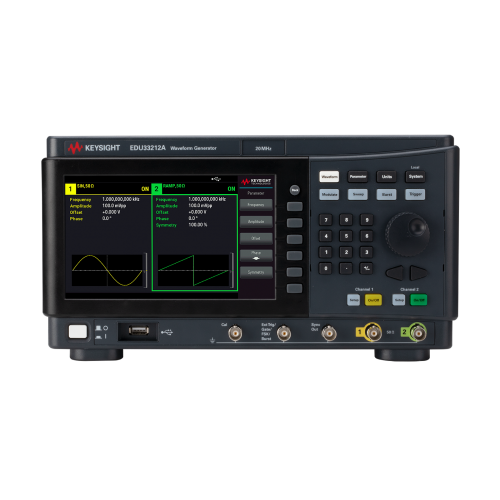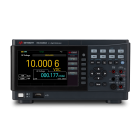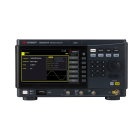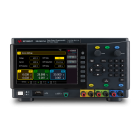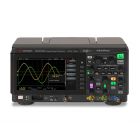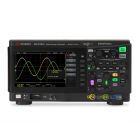Keysight Smart Bench Essentials - EDU33212A 20 MHz, Dual-Channel Function/Arbitrary Waveform Generator
Education partners save up to 30% off Keysight Smart Bench Essentials
The Keysight EDU33212A dual-channel function / arbitrary waveform generator offers the standard signals and features you expect — such as modulation, sweep, and burst. It also provides features that give you the capabilities and flexibility you need to get your job done quickly, no matter how complex. An intuitive, information-packed front-panel interface enables you to easily recall where you left off when your attention is focused elsewhere. And that is just the beginning.
Unlock the potential of your projects with the Keysight EDU33210 Series function/arbitrary waveform generators, designed to meet your diverse signal needs efficiently. Beyond delivering standard signals and essential features like modulation, sweep, and burst, these generators empower you with versatile functionalities for tackling even the most intricate tasks.
Experience seamless workflow management with an intuitive, information-rich front-panel interface that ensures easy navigation and quick access to your settings. Whether you're juggling multiple tasks or deeply engrossed in your work, the EDU33210 Series keeps you on track, allowing you to pick up right where you left off with ease.
Explore the possibilities with Keysight's EDU33210 Series – your key to productivity and precision in signal generation.
Features
Elevate your workflow with the advanced functionalities of the EDU33212A, engineered to streamline your parameter setup, signal viewing, and editing processes. Take advantage of the signature 7-inch colour display, offering intuitive navigation and real-time monitoring for seamless operation.
Explore a versatile array of modulation types, including six built-in options, coupled with 17 popular waveforms, meticulously crafted to simulate a wide range of typical applications for comprehensive testing scenarios.
Experience unparalleled flexibility with the EDU33212A's 16-bit arbitrary waveform capability, boasting memory capacity of up to 8 million samples per channel. This ensures precise waveform generation tailored to your exact specifications.
Stay connected from anywhere with the USB and LAN IO interface, facilitating seamless remote connectivity for enhanced accessibility and convenience.
Unlock the full potential of your device with Keysight's PathWave BenchVue software, empowering you with PC control capabilities to optimise your testing workflow like never before. Elevate your testing experience with the EDU33212A and revolutionise the way you approach signal generation and analysis.
Simple set up and operation
Enhance your lab capabilities with the cutting-edge features of the EDU33212A. This advanced equipment boasts a 7-inch WVGA color display, providing a comprehensive view of waveform settings and parameters in one glance. With its 20 MHz dual-channel function/arbitrary waveform generator, you can conveniently observe waveform information from both channels simultaneously.
Say goodbye to setup errors with the intuitive color-coded keypads and clear display and output connectors, ensuring seamless connections every time. What's more, the EDU33210 Series comes equipped with USB and LAN connectivity as standard, facilitating effortless remote access and control. Compatible with SCPI language, IVI driver, web browser, and Keysight's Pathwave BenchVue software, operating this device is a breeze.
Additionally, the built-in USB memory port allows for convenient storage of setup parameters using a USB flash drive. This feature streamlines efficiency by enabling quick restoration of setups across all function/arbitrary waveform generators in your lab. Experience enhanced productivity and precision with the EDU33210 Series.
Modulation and built-in waveforms
Enhance your signal generation capabilities with the versatile EDU33212A - part of the esteemed EDU33210 Series. This 20 MHz function/arbitrary waveform generator boasts an impressive array of 17 pre-loaded arbitrary waveforms, ensuring you have the perfect waveform for every application.
Among its offerings are fundamental waveforms like sine, square, ramp, triangle, pulse, PRBS, DC, and Gaussian noise, all conveniently illustrated in Figures 1 and 2 for easy reference. But that's just the beginning.
Dive deeper into its capabilities and discover specialty waveforms designed to meet more unique requirements. From cardiac and exponential fall/rise to Gaussian pulse, haversine, Lorentz, D-Lorentz, negative ramp, and sinc waveforms, the possibilities are extensive. Explore these diverse waveform options further in Figures 3 and 4.
But wait, there's more! The EDU33212A also features six built-in modulations, including AM, FM, phase modulation (PM), frequency-shift keying (FSK), binary phase shift keying (BPSK), and pulse width modulation (PWM), empowering you to tailor your signals with precision.
Experience the power and flexibility of the EDU33212A waveform generator, where versatility meets performance, enabling you to tackle even the most demanding signal generation tasks with confidence.
Signal Integrity: Outputting the Signals You Expect
Experience smooth sailing in your design endeavors with the EDU33210 Series function/arbitrary waveform generators. If your generator is causing disruptions with spurious signals or harmonics, achieving dependable designs becomes a daunting task. Opt for success by testing with immaculate, precise, and low-noise signals.
The EDU33210 Series stands out for its unparalleled signal fidelity, ensuring you can effortlessly generate the precise waveforms required for your most intricate measurements. Rest assured, with our generators, you'll accurately capture your design's characteristics, free from any interference from the waveform generator's measurements.
Arbitrary Waveform with Deep Memory
Looking to put your designs through rigorous testing using intricate, lengthy waveforms featuring diverse anomalies? Look no further than the EDU33210 Series function/arbitrary waveform generators. Equipped with a standard deep memory capacity of up to 8 million samples per channel, these generators can handle even the most complex test scenarios. With a maximum of 1 million samples per waveform, you'll have ample memory to tackle your toughest testing challenges.
-
Instrument
Models & Options Model Number EDU33212A Maximum Frequency 20 MHz Number of Channels 2 Waveforms Standard Sine, square, ramp, pulse, triangle, Gaussian noise, pseudorandom binary sequence (PRBS), DC Built-in Arbitrary Cardiac, exponential fall, exponential rise, Gaussian pulse, haversine, Lorentz, D-Lorentz, negative ramp, sinc User-defined Arbitrary Up to 8 MSa per channel; with up to 1 MSa per waveform Operating Modes and Modulation Types Operating Modes Continuous, modulate, frequency sweep, gated burst Modulation Types Amplitude modulation (AM), frequency modulation (FM), phase modulation (PM), frequency shift keying (FSK), binary phase shift keying (BPSK), pulse width modulation (PWM) Waveform
Sine Frequency Range 1 μHz to 20 MHz, 1 μHz resolution Amplitude Flatness
(Specification) 1, 2, 12
(Relative to 1 kHz)1 Vpp < = Vout < = 10 Vpp (50 Ohm load)fOUT < = 100 KHz: ±0.1 dB100 KHz < fOUT < = 5 MHz: ±0.15 dB5 MHz < fOUT < = 20 MHz: ±0.3 dBHarmonic
Distortion (Typical) 1, 2, 12 (Relative to 1 kHz)1 Vpp < = Vout < = 10Vpp (50 Ohm load)
fOUT < = 100 KHz: -60 dBc
100 KHz < fOUT < = 1 MHz: -50 dBc
1 MHz < fOUT < = 20 MHz: -40 dBcTHD (typical) 1 fOUT = 10 Hz to 20 kHz: < 0.075% Non-harmonic
Spurious (Typical) 1, 3, 12fOUT ≤ 2 MHz: <- 70 dBc
fOUT > 2 MHz: < - 70 dBc + 20 dB / decadePhase Noise (SSB)
(Typical) 410 kHz offset: -105 dBc / Hz Square and Pulse Frequency Ranges 1 μHz to 10 MHz, 1 μHz resolution Rise and Fall Times
(Nominal)Square at 8.4 ns, fixed
Pulse at 8.4 ns to 1 us, independently variable, 100 ps resolutionOvershoot (Typical ≤ 3%Duty Cycle 5 0.01% to 99.99%, 0.01% resolutionPulse Width 16 ns minimum (adjustable with 100 ps resolution)Jitter (RMS) (Measured) 4 ≤ 5 MHz: 2 ppm of the period + 100 ps
> 5 MHz: 100 psRamp and Triangle Frequency Range 1 μHz to 200 kHz, 1 μHz resolution Ramp Symmetry 0% to 100%, 0.1% resolution, (0% is negative ramp, 100% is positive ramp, 50% is triangle) Linearity (Typical) ≤ 0.1% from 5% to 95% of the signal amplitude (Vout ≥ 1 Vpp) Gaussian Noise Variable Bandwidth 1 MHz to 20 MHz Crest Factor (Nominal) 4.6 Repetition Period > 50 years Pseudorandom Binary Sequence (PRBS) Bit Rate 1 Mbps to 50 Mbps, 1 Mbps resolution Sequence Length 2 m - 1, m = 7, 9, 11, 15, 20, 23 Rise and Fall Times 8.4 ns to 1 μS, independently variable, 100 ps resolution Arbitrary Waveforms Waveform Length 8 Sa to 8 MSa per channel (maximum up to 1 MSa per waveform) Sample Rate 1 μSa/s to 250 MSa/s, 1 μSa/s resolution Voltage Resolution 16 bits General Connector Front-panel BNC, shell connected to chassis; all inputs and output BNC connectors are chassis-referenced Function On, off, or inverted Output Impedance
(Nominal)50 Ω Isolation Connector shells for channel output(s), sync, and modulation "in" are connected Overload Protection Output turns off automatically when an overload is applied; the instrument will tolerate a short circuit to ground indefinitely Amplitude Range 6 1 mVpp to 10 Vpp into 50 Ω, 4-digit resolution
2 mVpp to 20 Vpp into open circuit, 4-digit resolutionUnits Vpp, Vrms, or dBm Accuracy (at 1 kHz Sine)
(Specification) 2,12± (2% of setting in Vpp) ± (1 mVpp) Accuracy (at 1 kHz Sine)
(Typical) 12± (1% of setting in Vpp) ± (1 mVpp) Voltage Limit Function User-definable maximum and minimum voltage limits DC Offset Range 13 ± (5 VDC minus peak AC) into 50 Ω, 4-digit resolution
± (10 VDC minus peak AC) into open circuit, 4-digit resolutionUnits VDC Accuracy (specification) 2,12 ± (1% of offset setting) ± (1% of amplitude in Vpp) ± (5 mV) Frequency Accuracy (Spec) Standard Frequency
Reference± (1 ppm of setting + 15 pHz), 1 year, 23 ºC ± 5 ºC
± (2 ppm of setting + 15 pHz), 1 year, 0 ºC to 55 ºCModulation, Burst and Sweep
Amplitude Modulation (AM) Source Internal only Carrier Waveform Sine, square, ramp, arbModulating Waveform Sine, square, ramp, noise, arb Depth 2, 8 0% to 120%, 0.01% resolution Frequency Modulation (FM) 9 Source Internal only Carrier Waveform Sine, square, ramp, arb Modulating Waveform Sine, square, ramp, noise, arb Deviation 1 μHz to 15 MHz, 1 μHz resolution Phase Modulation (PM) Source Internal only Carrier Waveform Sine, square, ramp, arb Modulating Waveform Sine, square, ramp, noise, arbModulation Frequency 2 MHz to 1 MHzDeviation 0º to 360º, 0.1º resolutionFrequency-Shift Key Modulation (FSK) 12 Source Internal or external connector Rate ≤ 1 MHz Binary Phase-Shift Key Modulation (BPSK) Source Internal or external connector Phase Shift 0º to 360º, 0.1º resolution Rate ≤ 1 MHz Pulse Width Modulation (PWM) Source 1 Mbps to 50 Mbps, 1 Mbps resolution Carrier Waveform Pulse Modulating Waveform Sine, square, ramp, noise, arb Deviation 5 0% to 100% of pulse width, 0.01% resolution Burst Characteristics 7 Type Counted or gated Counted Burst Operation Each trigger event causes the instrument to produce from 1 to 108 or an infinite number of waveform cycles Gated Burst Operation Instrument produces waveforms while the trigger is in the "on" state. For Gaussian noise, waveform generation stops immediately when the trigger is in the "off" state; all other waveforms stop after the completion of a cycle; more than one cycle might elapse before generation stops Start / Stop Phase 14 -360° to +360°, 0.1° resolution Trigger Source Internal timer or rear-panel connector Marker Indicated by the trailing edge of the sync pulse; adjustable to any cycle of the burst Sweep Characteristics 9 Type Linear, logarithmic, or list (up to 128 user-defined frequencies) Operation Characterization of linear and logarithmic sweeps occur by a sweep time during which the frequency changes smoothly from start to stop; a hold time during which the frequency stays at the stop frequency; and a return time during which the frequency changes smoothly from stop to start Direction Up (start frequency < stop frequency) or down (start frequency > stop frequency) Sweep Time Linear 1 millisecond to 3,600 seconds, 1 ms resolution Logarithmic 3,601 seconds to 250,000 seconds, 1 second resolution Hold Time 1 millisecond to 500 seconds, 1 ms resolution Return Time 0 to 3,600 seconds, 1 ms resolution Trigger Source 10, 11 0 to 3,600 seconds, 1 ms resolution Two-Channel Characteristics
Standard Operating Modes Independent, coupled parameter(s), combined (Channels 1 and 2);
equal (Channel 1 = Channel 2) or differential (Ch 1 = -Ch 2)Parameter Coupling None, frequency (ratio or difference) and / or amplitude and DC offset Relative Phase 0° to 360° , 0.1° resolution Channel-to-Channel Skew (Typical); Both Channels Configured Identically < 0.8 ns Crosstalk (Typical) < -75 dB Sync Out / Trigger Out
General Connector Front BNC, chassis-referenced; functions as an output Minimum Output High Voltage Minimum 1.3 V Maximum Output Low Voltage Maximum 0.1 V External Trigger Input / Gate; Input / Burst; Input / FSK Input
General Connector Front BNC, chassis-referenced; functions as input Polarity Positive or negative slope Maximum Rate 1 MHz Input Minimum Input High Voltage 2.2 V Maximum Input Low Voltage 0.6 V Minimum Pulse Width 16 ns Variable Trigger Delay 0 to 1,000 s; 4 ns resolution Latency (Typical) < 160 ns with trigger delay set to zero Jitter < 2.5 ns, rms Memory
Instrument State Store / Recall User-defined instrument states with user-defined names in the file system Power-on State Default settings or state at power-off, selectable USB File System Front-panel Port USB 2.0 high-speed mass storage class (MSC) device Capability Read or write instrument configuration settings, instrument states, arbitrary waveform Speed (Nominal) 10 MB/s General Characteristics
USB File System LXI-C (rev1.5) 10/100Base-T (sockets and VXI-11 protocols); USB 2.0 (USB-TMC488 protocol) Web User Interface Remote operation and monitoring Programming Language SCPI-1999, IEEE-488.2 Real-time Clock / Calendar
BatteryCR-2032 coin type, replaceable, > 5-year life (typical) Mechanical Size (Nominal) 314 mm W x 130 mm H x 165 mm D (12.36 in W x 5.12 in H x 6.50 in D) Weight (Nominal) 3.1 kg (6.8 lbs.) Environmental Storage Temperature -40 °C to 70 °C Warm-up Time 1 hour Operating Environment Indoor use, installation category II for AC input; pollution degree 2 Operating Temperature 0 °C to 55 °C Operating Humidity Up to 80% RH at 40 °C non-condensing Altitude Up to 3,000 meters (9842.5 ft) Regulatory Electromagnetic
CompatibilityCompliant with EMC directive (2014/30/EU)
IEC 61326-1/EN 61326-1 Group 1 Class A
Canada: ICES/NMB-001
Australia / New Zealand: AS/NZS CISPR 11
South Korea: KC mark
(South Korean Class A EMC declaration:
Information to the user:
This equipment has been conformity assessed for use in business environments. In a residential environment, this equipment may cause radio interference.)Safety IEC 61010-1 / EN 61010-1
USA: ANSI/UL Std. No. 61010-1
Canada: CAN/CSA-C22.2 No.61010-1Acoustic Noise Sound pressure level (1 m free field) (nominal) 31 dB(A) at ambient ≤ 28 °C Line Power Line Voltage 100 to 240 V, 50 / 60 Hz; 100 to 120 V, 50 / 60 Hz Power Consumption < 45 W

